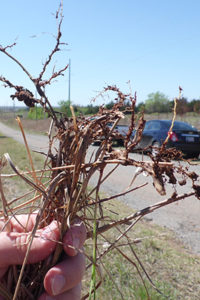 Many of the old narratives I read talk about how the grass in the south-central Washita Valley was belly high to a horse when non-indigenous settlers first came to the area. In my work, I drive through my area of interest at least once a week and, after months of looking and looking, I began to wonder: What was that grass and where is it now? I have reached that place in my study where I need to visualize what our world looked like in 1870.
Many of the old narratives I read talk about how the grass in the south-central Washita Valley was belly high to a horse when non-indigenous settlers first came to the area. In my work, I drive through my area of interest at least once a week and, after months of looking and looking, I began to wonder: What was that grass and where is it now? I have reached that place in my study where I need to visualize what our world looked like in 1870.
I am not well-schooled in botany or vegetation ecology. In fact, I have learned I am not well-informed about a lot of things. However, I have learned during my research (as well as during my life) that there are experts in everything all around me just waiting to be asked. And everyone I have asked about all kinds of stuff during this project have been more than willing to help explain things to me. It’s rather heartening!
For example, Phillip Thurston proved quite well-informed about the use of fire by indigenous people and seemed happy to share his knowledge with me. (Either he was happy or I was just happy to get his information….LOL!) Chris Witt and James McElvaney have patiently explained the benefits of no-till farming to me. This is important because it helps to understand why some old sites in the area yield lots of artifacts and some offer less. I think I shall continue to write books from now on, if only for the conversation the effort elicits from other people. This is a lot of fun!
When I set out to learn about that tall grass and what happened to it, I started with Tra Ketchum, who I recalled got a college degree in a somewhat related area. He was tremendously helpful, offering educated insights and opinions. Tra then referred me to our local Soil Conservation office, now known as the Natural Resources Conservation Service (NRCS).
Now, Tra is of my tribe, so to speak. He is from Alex and I have known him all his life. When talking to me, he was apparently immune to my penchant for peppering people with endless, sharp-edged questions. However, the fellow Tra referred me to was not so tolerant of my overly inquisitive behavior. After speaking to Travis Jones of the local NRCS for a few minutes on phone, he said…Look, lady, I have never been questioned so much in my life! I apologized profusely, thinking my opportunity was lost, but it turns out the young gentleman was not terminally offended after all! He invited me to his office for a full “learning session” that would help me understand what our little slice of the prairie might have looked like in the 1870s. He also agreed to find me a patch of native grasses growing in their native state in our local area as close to the Washita as possible. I had a day of vacation to burn so I took him up on his offer.
What an education! With the assistance of color prints Travis had gathered just for me, I learned that the grass that sometimes towered as high as a horse’s head in the early days was Big Blue Stem, likely supplemented by Indian grass. Big Blue Stem held the plains together against the ravages of wind and the onslaught of torrential water because its roots are rhizomes, that is, they are extended runners that knit together under the soil. I probably sound like a neophyte to those more educated in this discipline than me but I was glad to understand.
And what has happened to Big Blue Stem? Sadly, it’s almost completely gone from the bottom land where it grew in such profusion long ago that many settlers topped the rocky ridges of the rolling prairie, looked down into the creek bottoms and proclaimed them another paradise in God’s Country. Big Blue Stem has been mostly plowed up now and does not return unless re-seeded.
Despite this unfortunate news, Travis found me a small patch growing in a virgin, never-plowed area pretty near the Little Washita to keep an eye on in the upcoming weeks. After we traveled there, Travis patiently pointed out the Big Blue Stem and Indian grass growing on one side as opposed to the Johnson Grass weed growing on the other and taught me how to identify each on my own. It felt almost like a crime of some kind when Travis pulled up a clump of Big Blue Stem so I could see the rhizome roots shown in the photo for myself. For the want of these, half of Oklahoma blew away during the Dust Bowl…
(Calling on my own expertise, I explained to Travis that Steinbeck’s novel, “The Grapes of Wrath,” was a good book but not to be taken for fact. LOL!)
Thanks to all the incredibly knowledgeable people around me, I am gaining a basic understanding of the dynamics of water, wind, vegetation and fire that shaped Indian Territory, and I find myself with a picture of a land that looked very different from what we see today.
